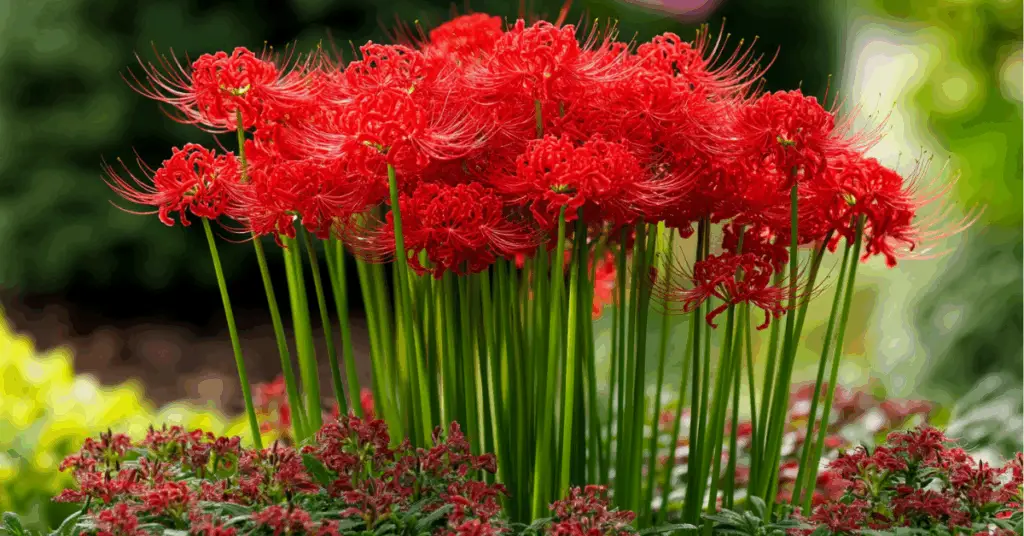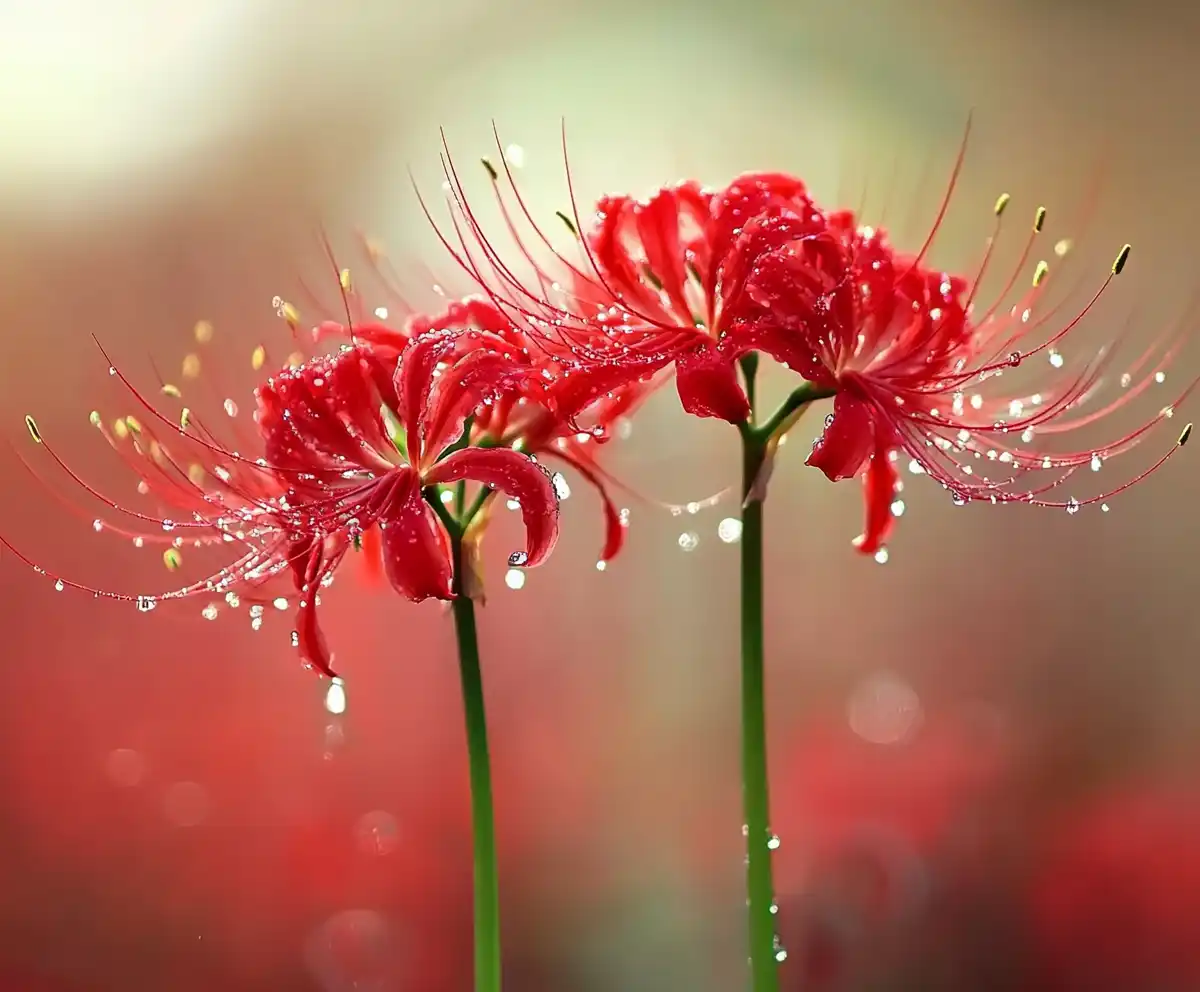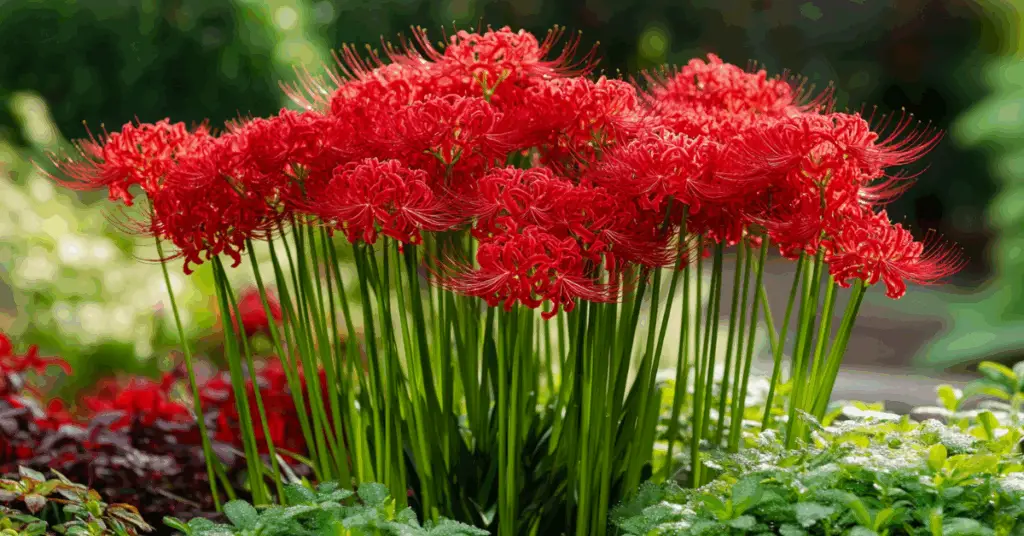If you’re looking to add an eye-catching burst of color to your garden just as summer gives way to fall, spider lilies are a must-have. Known for their long, delicate petals and dramatic, leafless stems during bloom, spider lilies (Lycoris radiata) offer a striking visual unlike anything else in the garden. These easy-to-grow perennials emerge when most summer flowers begin to fade, giving your landscape a fresh pop of red and a subtle, pleasant fragrance.
In this guide, you’ll learn how to grow and care for spider lilies from bulb to bloom — including tips on sunlight, soil, watering, and overwintering — all tailored to help your lilies thrive year after year.
Sunlight Requirements for Spider Lilies
Spider lilies love the sun, but like many bulbs, they benefit from a balanced approach depending on your climate.
☀️ Full Sun for Strong Blooms
- Aim for at least 6 hours of direct sunlight daily.
- In milder climates, full sun helps promote vigorous flowering and strong growth.
🌤️ Partial Shade in Hot Regions
- If you’re in a hot or humid zone, give your lilies morning sun and afternoon shade to avoid heat stress.
- They can tolerate partial shade, but too much darkness may reduce blooms.
📌 Pro Tip: A south- or east-facing garden bed is often ideal for spider lilies.
Preparing the Soil for Healthy Spider Lily Growth
Healthy spider lilies start with well-prepped soil. Since these plants grow from bulbs, the right foundation ensures strong roots, vibrant blooms, and low-maintenance care throughout the season.
🌱 Enrich with Compost Before Planting
- Mix 2–4 inches of compost into the top 12 inches of soil before planting.
- Compost boosts drainage, enhances aeration, and provides slow-release nutrients that benefit bulbs over time.
🧱 Well-Drained Soil Is Key
- Spider lilies don’t like soggy conditions. Ensure your garden bed drains well to prevent rot.
- Raised beds or sandy loam soils are ideal for areas with heavy clay.
📌 Quick Tip: Avoid synthetic fertilizers at planting time—compost provides all the nutrients spider lilies need to get established naturally.
Planting Spider Lily Bulbs: Depth, Spacing, and Container Tips

Planting spider lilies may seem straightforward, but a few key steps make all the difference in how well they bloom. These bulbs prefer a bit of breathing room and shouldn’t be buried too deep.
🌸 How to Plant Spider Lily Bulbs
- Shallow Planting is Best:
Place each bulb so that its “neck” (the pointed top) is just barely covered with soil. Planting too deep can hinder blooming. - Proper Spacing Matters:
Space bulbs about 8 inches apart to allow plenty of room for their foliage and future growth. Crowding can lead to weaker plants and fewer flowers.
🪴 Tips for Planting in Containers
- Choose a pot that is at least 18 inches deep to comfortably fit the developing root system.
- Use a well-draining potting mix combined with compost.
- Make sure the container has ample drainage holes to prevent waterlogging, which can cause bulb rot.
📌 Quick Tip: When planting multiple bulbs in a container, maintain the same 8-inch spacing to avoid overcrowding.
Watering Spider Lilies for Healthy Growth
Watering spider lilies properly is crucial to supporting their life cycle. These bulbs have different needs depending on whether they are actively growing or resting.
💧 During Growth and Bloom
- Keep the soil evenly moist while spider lilies are growing and flowering.
- Water deeply, allowing moisture to reach the entire root zone.
- Avoid soggy conditions — consistent, moderate moisture is ideal, not standing water.
🌾 During Dormancy
- After flowering, spider lilies enter a dormant stage where watering needs decrease.
- Water just enough to prevent the soil from becoming completely dry.
- Use a moisture meter or simply check the top 2 inches of soil — water lightly if it feels dry.
📌 Quick Tip: Always water around the bulb, not directly on top of it, to encourage roots to spread naturally.
Maintenance and Overwintering Tips for Spider Lilies

Caring for spider lilies after they bloom helps ensure vibrant flowers year after year. A little post-bloom maintenance goes a long way toward keeping the bulbs healthy and strong.
✂️ Post-Bloom Maintenance
- Remove spent flowers immediately after blooming to tidy the plant and redirect energy to the bulb.
- Leave the foliage intact until it naturally turns yellow. The leaves are busy photosynthesizing and storing energy for next season’s blooms.
- Only cut back leaves once they are completely yellow and wilted.
❄️ Overwintering in Frost-Prone Areas
- In regions with harsh winters, spider lily bulbs need extra protection:
- Gently dig up the bulbs before the first hard frost.
- Clean off any remaining soil without damaging the bulbs.
- Wrap bulbs loosely in newspaper.
- Store them in a warm, dry place (like a basement or garage) where they won’t freeze.
- Replant in early spring once all danger of frost has passed.
📌 Quick Tip: Label your stored bulbs by variety if you’re growing multiple types of lilies—it’ll save guessing next planting season!
Frequently Asked Questions About Growing Spider Lilies
❓ When is the best time to plant spider lily bulbs?
The best time to plant spider lily bulbs is in late summer to early fall, after the hottest part of summer but before the first frost. This timing allows the bulbs to establish roots before going dormant.
❓ How deep should I plant spider lily bulbs?
Plant spider lily bulbs shallowly, covering the neck of the bulb with just a thin layer of soil. Planting too deep can delay or prevent blooming.
❓ Do spider lilies need a lot of water?
Spider lilies need even, consistent moisture during their active growing and blooming phases. However, during their dormant period, they require only light watering to prevent the soil from completely drying out.
❓ Can spider lilies survive the winter outdoors?
In mild climates, spider lilies can overwinter in the ground. In frost-prone areas, it’s safer to dig up the bulbs before the first hard frost and store them indoors in a dry, warm place.
❓ Are spider lilies toxic to pets?
Yes, spider lilies are toxic to cats, dogs, and other pets if ingested. It’s best to plant them in areas that are out of reach of curious animals.
❓ How long do spider lilies bloom?
Spider lilies typically bloom for about two weeks in late summer or early fall, depending on your local climate and growing conditions.
Conclusion: Bring Late-Season Magic to Your Garden with Spider Lilies
Learning how to grow and care for spider lilies is simple once you know their sunlight, soil, and seasonal needs. These stunning, low-maintenance bulbs reward gardeners with vivid red blooms, sweet fragrance, and an unexpected late-summer spectacle. With the right planting techniques, careful watering, and a little seasonal TLC, spider lilies can thrive and return year after year, brightening your garden just when you need it most.


